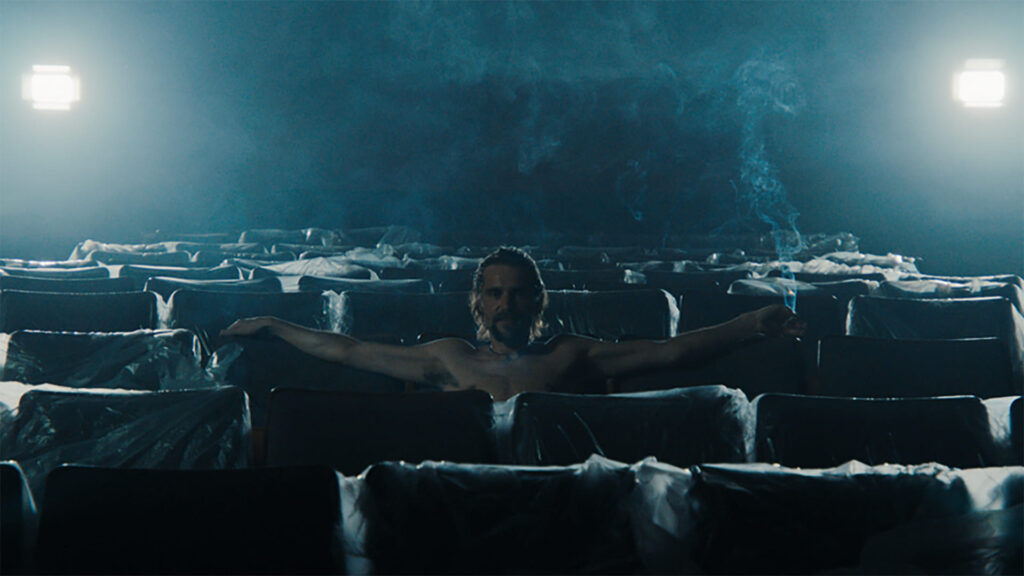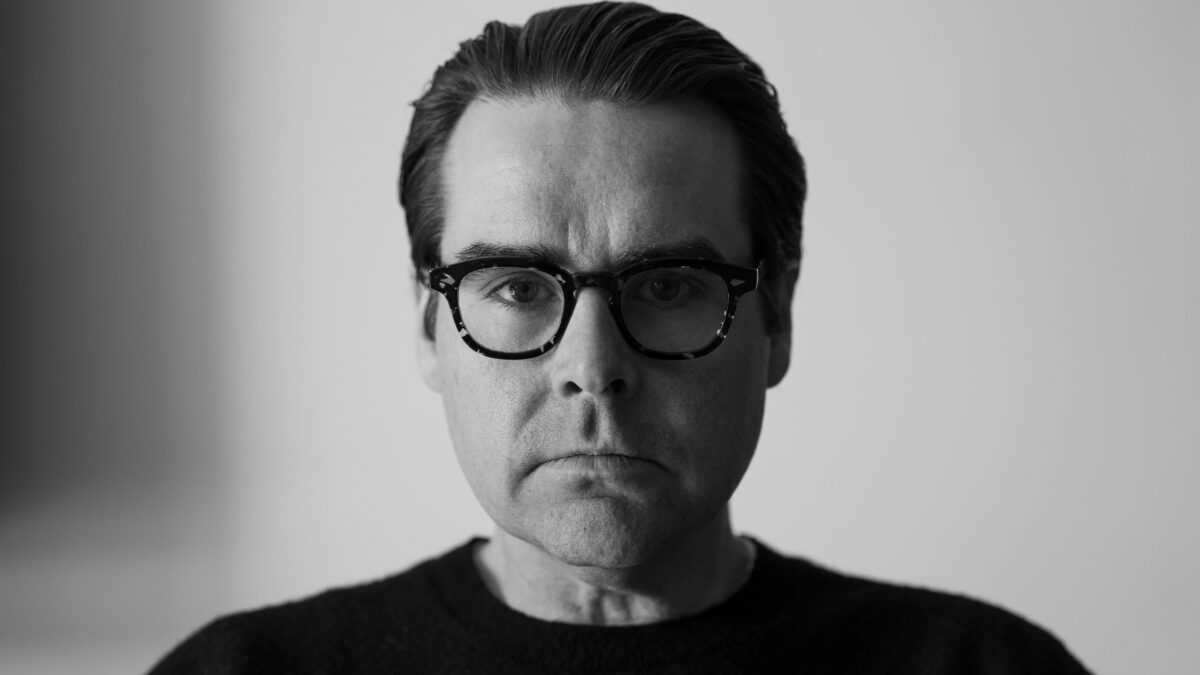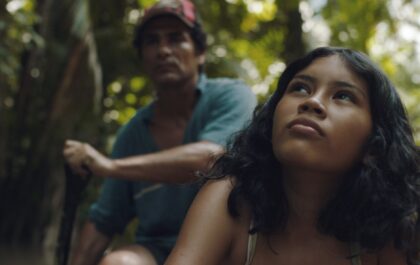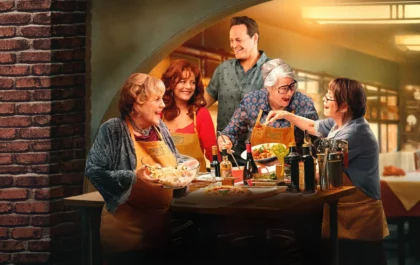De in Los Angeles levende en werkende Joshua Erkman is een bijzonder veelzijdig man. Zo drumt hij bij het noise trio LAMPS, brengt hij met zijn label Capes and Fog gelimiteerde cassettes met eigen werk en dat van van bevriende geluidskunstenaars uit, levert hij als fotograaf bijzonder knap werk af (o.a. te bewonderen op zijn Instagram-acccount) en schoot hij videoclips voor bijv. The C.I.A. en Ty Segall.
Maar dat is nog niet alles. Na eerder 4 kortfilms te hebben gedraaid, releasede hij in 2024 met A Desert zijn eerste langspeelfilm. De film die zijn Belgische première beleeft op het Offscreen Film Festival, vertelt het verhaal van een fotograaf wiens carrière in het slop zit en inspiratie zoekt in de woestijn, maar zijn plannen worden overhoop gegooid door een lawaaierig koppel in het motel. Deze neo-noir thriller sleurt je mee in een nachtmerrie-achtige exploratie van de Amerikaanse iconografie van motels en roadside diners, die langzaamaan opgeslorpt worden door de weidse, nietsontziende wreedheid van het landschap.

Welke films inspireerde Joshua Erkman bij het draaien van A Desert? Hij vond tussen zijn drukke bezigheden de tijd om het met ons te delen:
Psycho (1960 – Alfred Hitchcock)
Als tiener had ik een poster van Psycho in mijn slaapkamer hangen. Ik ben er zeker van dat het feit dat ik er elke avond naar keek voordat ik in slaap viel, een onuitwisbare indruk op me heeft achtergelaten. Er is niets wat ik over deze film kan zeggen dat niet al eerder is gezegd—het is een meesterwerk. Het oorspronkelijke idee achter A Desert was om te kijken of ik een verhaallijn die iedereen kent (Psycho) kon gebruiken om iets groters, iets meer omvattend te vertellen en tegelijkertijd het publiek toch te verrassen. Of dat experiment geslaagd is, laat ik uiteraard aan de kijker over.
The Sadist aka Sweet Baby Charlie aka Profile of Terror (1963 – James Landis)
Deze rauwe interpretatie van de moordtocht van Charles Starkweather en zijn vriendin Caril Fugate in de late jaren vijftig was de eerste film waarvoor Vilmos Zsigmond als cinematograaf werd gecrediteerd. Maar misschien nog belangrijker is de uitzinnige vertolking van tieneracteur, muzikant en drager van de meest waanzinnige pompadour aller tijden: Arch Hall Jr., in de rol van psychopaat Charlie Tibbs. De film is te zien op de moteltelevisies in A Desert—een overduidelijke knipoog naar het type film waar de kijker naar kijkt. Leuk detail: Arch Hall Jr. schreef een van mijn favoriete nummers, Monkey in my Hatband. Ik zou willen dat dit op mijn begrafenis wordt gedraaid.
The Passenger (1975 – Michelangelo Antonioni)
Een existentiële reis door een andere woestijn, de Sahara, met Jack Nicholson als een gedesillusioneerde journalist die de identiteit van een ander aanneemt. De sfeer, toon en bedachtzame vertelwijze van The Passenger—vooral in de eerste vijftien minuten—waren voortdurend in mijn gedachten bij de introductie van Alex, de fotograaf en protagonist van A Desert. De film eindigt bovendien met een van de meest iconische shots in de filmgeschiedenis.
The Limey (1999 – Steven Soderbergh)
Waarschijnlijk mijn favoriete Steven Soderbergh-film. De visuele stijl, de dromerige score van Cliff Martinez en de fenomenale acteerprestaties van sixties-iconen Terence Stamp en Peter Fonda blijven me keer op keer terugbrengen naar deze film. De montage van The Limey bouwt voort op wat John Boorman deed in Point Blank, door herinneringen op een cinematografische manier te presenteren. Hierdoor wordt een vrij rechttoe-rechtaan wraakverhaal getransformeerd tot iets kunstzinnigs. The Limey, samen met Cure van Kiyoshi Kurosawa, was een belangrijke inspiratiebron voor de montageaanpak van A Desert, iets waar editor Star Rosencrans en ik veel over hebben gesproken.
Somewhere to Disappear (2010 – Laure Flammarion & Arnaud Uyttenhove)
Een nauwelijks bekende, maar intrigerende documentaire van een uur, waarin de hedendaagse fotograaf Alec Soth wordt gevolgd terwijl hij door Amerika reist en werkt aan zijn Broken Manual-project. Ik zag deze documentaire pas nadat ik het script voor A Desert had geschreven, en ik was er volledig door weggeblazen. Het legde op een prachtige manier vast wat ik in mijn film probeerde te vangen met de fotograaf als protagonist. Het bevestigde dat de manier waarop de personages in A DESERT zich gedragen en voelen, authentiek en oprecht was. De documentaire bevat momenten die gespannen, emotioneel en zelfs beangstigend zijn, zoals wanneer Soth in een donkere, vervallen woning een man opnieuw bezoekt die hij eerder had ontmoet. De scène begint als iets angstaanjagends en eindigt met een hartverscheurend moment.
English Version:
Los Angeles-based and working Joshua Erkman is a particularly versatile man. He plays drums with the noise trio LAMPS, his label Capes and Fog releases limited edition cassettes with his own work and that of collaborators, his work as a photographer is remarkable (you can admire it on his Instagram account) and he has shot music videos for The C.I.A. and Ty Segall.
But that’s not all. After previously shooting 4 short films, he released his first full-length film in 2024 with A Desert. The film, which has its Belgian premiere at the Offscreen Film Festival, tells the story of a photographer whose career is in the doldrums and seeks inspiration in the desert, but his plans are thrown upside down by a noisy couple in the motel. This neo-noir thriller drags you into a nightmarish exploration of the American iconography of motels and roadside diners, slowly being swallowed up by the vast, ruthless brutality of the landscape.
What films inspired Joshua Erkman to shoot A Desert? Between his busy pursuits, he found time to share it with us:
Psycho (1960 – Alfred Hitchcock)
As a teenager I had a poster for Psycho hanging in my bedroom. I’m sure that seeing it on my wall night after night as I drifted off to sleep had an indelible impact on me. There’s nothing I can say about the film that hasn’t already been said before, it is a masterpiece. The initial conceit of A Desert was to see if I could take a plot structure everyone is familiar with (Psycho) and make it about something bigger, something more, and still manage to surprise the audience. Whether that experiment works or not, that’s obviously up to the viewer.
The Sadist aka Sweet Baby Charlie aka Profile of Terror (1963 – James Landis)
This scrappy riff on the late 1950’s killing spree of Charles Starkweather and his girlfriend Caril Fugate was Vilmos Sigmond’s first cinematographer credit. More importantly though is that it has an absolutely wild performance by teen actor/musician/wearer of the craziest pompadour of all time, Arch Hall Jr. in the role of psycho killer Charlie Tibbs. The movie plays on the motel TVs in A Desert and is my very on the nose nod to what type of movie you are watching. Worth noting Arch Hall Jr. wrote one of my favorite songs, Monkey in my Hatband, I’d like it to be played at my funeral.
The Passenger (1975 – Michelangelo Antonioni)
An existential trip in a different desert, the Sahara, with Jack Nicholson as a disaffected journalist that assumes the identity of another man. The mood, tone, and deliberate pacing in The Passenger, particularly in the opening fifteen minutes of the film, was something always in my mind as we first meet Alex, the protagonist photographer in A Desert. And the movie ends with one of the all-time great shots in cinema history.
The Limey (1999 – Steven Soderbergh)
Probably my favorite Steven Soderbergh movie. The visual style of the movie, the dreamy Cliff Martinez score, and the fantastic performances by 60’s icons Terence Stamp and Peter Fonda keep me coming back to it. The editing style of The Limey further expands on what John Boorman achieves in Point Blank with his approach to presenting memories cinematically and turns a middle of the road revenge pulp story into something more artful. The Limey along with Kiyoshi Kurosawa’s Cure, were influences and very much a part of the conversation with our editor, Star Rosencrans on the approach to editing A Desert.
Somewhere to Disappear (2010) – Laure Flammarion and Arnaud Uyttenhove)
An hour-long underseen documentary that follows contemporary photographer Alec Soth as he drives around America working on his “Broken Manual” project. I saw this documentary after I wrote the script for A Desert and it really blew me away with how it so beautifully documented what I was trying to capture in A Desert with our photographer protagonist. It gave me confirmation that how the characters in A Desert behave and feel, was authentic and true. There are moments that are tense, emotional, and even scary as Soth interacts with people living off the grid in the abandoned and desolate fringes of America. In one sequence Soth returns to see a man he met during a previous trip. This man is living alone in a dark ramshackle house, lit with a single lightbulb, the interaction starts off terrifying and ultimately breaks your heart.








